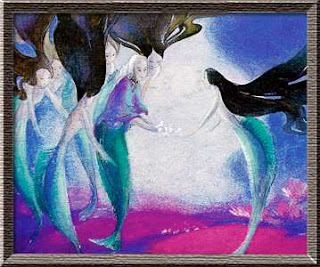Gustav Klimt, beloved Symbolist painter used women frequently as creative subjects. These two paintings depict "Water Serpents" as he termed them.
Wednesday, January 20, 2010
Saturday, November 14, 2009
Mermen
The Merman is the lesser known counterpart of the mermaid. He seduces humans though not to the extent of
the mermaid. The merman figures largely in non-western lore - he is present in Indian, Babylonian and Indonesian mythology. In Ovid's Metamorphosis, Glaucus was a humble fisherman who discovered a magic herb that brought dead fish back to life. Not knowing its effects on humans, Glaucus tried it and immediately grew a fish tale and became a merman. He received immortality but had to leave the land for the sea. He became a demi-god thereafter. He later fell in love with the beautiful Scylla. She was repulsed by his features and ran away. Glaucus asked Circe for a love potion to give to Scylla; however, Circe herself was in love with Glaucus. He did not return her love and so she punished Scylla by turning her into a horrible sea monster (Metamorphosis - Ovid).
Matthew Arnold (1822-1888) wrote the poem "The Forsaken Merman" about a woman who marries a merman and has children with him but abandons them for a respectable religious existence on the land. Click the link to read it here: http://bartleby.com/101/747.html
Undine
Undine is a water sprite of Germanic origins. Powerful and enigmatic, she has no soul but may marry a human and attain a soul that way. ( "Undine." Encyclopedia Mythica from Encyclopedia Mythica Online.).
Undine, or Ondine is present in modern fiction, art and music. Undine's romance is the subject in Friedrich de la Motte Fouque's Undine, published in 1811:
http://www.gutenberg.org/files/2825/2825-h/2825-h.htm
Undine is also the subject of French poet Aloysius Bertrand's poem cycle "Gaspard de la Nuit." Unfortunately no English translation exists online but Maurice Ravel adapted the poems to music. Below is the 1906 composition of the first movement of Ravel's "Gaspard" entitled "Ondine"l
Undine and Huldbrand - Henry Fuseli (1819) (the two main characters in La Motte Fouque's novella)
Undine is a water sprite of Germanic origins. Powerful and enigmatic, she has no soul but may marry a human and attain a soul that way. ( "Undine." Encyclopedia Mythica from Encyclopedia Mythica Online.).
Undine, or Ondine is present in modern fiction, art and music. Undine's romance is the subject in Friedrich de la Motte Fouque's Undine, published in 1811:
http://www.gutenberg.org/files/2825/2825-h/2825-h.htm
Undine is also the subject of French poet Aloysius Bertrand's poem cycle "Gaspard de la Nuit." Unfortunately no English translation exists online but Maurice Ravel adapted the poems to music. Below is the 1906 composition of the first movement of Ravel's "Gaspard" entitled "Ondine"l
Undine and Huldbrand - Henry Fuseli (1819) (the two main characters in La Motte Fouque's novella)
Kay Nielsen's vision
If you've seen Disney's "The Little Mermaid" (1989), you'll note the similarities between that movie and Kay Nielsen's artwork. Nielsen painted the pictures in the 1940s for a movie he believed would be made at that time. It was not until the 1980s that his vision would be realized on screen.
The Mermaid
A mermaid found a swimming lad,
Picked him for her own,
Pressed her body to his body,
Laughed; and plunging down
Forgot in cruel happiness
That even lovers drown.
- W.B. Yeats
The poem by Yeats encapsulates the major problem with water women who love land men. They simply cannot cohabit the same place. Unfortunately, the men nearly always want to live with their mermaid lovers and forget that they cannot breathe underwater. Thus the mermaid is a powerful seductress and her love means death to the hapless sailor or fisherman. Until Hans Christian Andersen's famous story "The Little Mermaid," these water spirits enjoyed quite a reputation as femme fatales. Click the link to read the ballad of "Clerk Colvill" who was killed by his mermaid lover:
http://www.sacred-texts.com/neu/eng/child/ch042.htm
The Fisherman and the Syren - Frederic Lord Leighton (1830-1896)
Picked him for her own,
Pressed her body to his body,
Laughed; and plunging down
Forgot in cruel happiness
That even lovers drown.
- W.B. Yeats
The poem by Yeats encapsulates the major problem with water women who love land men. They simply cannot cohabit the same place. Unfortunately, the men nearly always want to live with their mermaid lovers and forget that they cannot breathe underwater. Thus the mermaid is a powerful seductress and her love means death to the hapless sailor or fisherman. Until Hans Christian Andersen's famous story "The Little Mermaid," these water spirits enjoyed quite a reputation as femme fatales. Click the link to read the ballad of "Clerk Colvill" who was killed by his mermaid lover:
http://www.sacred-texts.com/neu/eng/child/ch042.htm
The Fisherman and the Syren - Frederic Lord Leighton (1830-1896)
Friday, November 13, 2009
Arthur Rackham

Subscribe to:
Comments (Atom)













.jpg)




